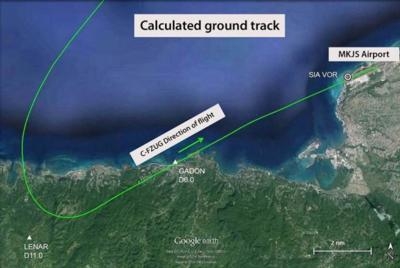Wed, Jan 11, 2017
Unstable Approach Led To The Incident Involving An Air Canada Rouge Flight
The has Transportation Safety Board of Canada (TSB) determined that an unstable approach led to the 10 May 2014 hard landing of an Air Canada Rouge Airbus A319 at the Sangster International Airport in Montego Bay, Jamaica.

There were no injuries and no structural damage to the aircraft.
The TSB said in its report that the Air Canada Rouge Airbus A319 was operating as flight AC1804 from Toronto, Ontario, to Montego Bay, Jamaica, with 131 passengers and 6 crew members on board. At approximately 14 minutes before touchdown, the aircraft was cleared for a non-precision approach to Runway 07 at the Montego Bay airport. The approach became unstable and the aircraft touched down hard. The landing subjected the main landing gear to very high loading. The aircraft was subsequently inspected and the main landing gear shock absorbers were replaced as a precaution.
The investigation determined that the approach became unstable as a result of inconsistent airspeed management and delayed configuration of the aircraft for landing. The flight crew did not adhere to standard operating procedures, which required the monitoring of all available parameters during approach and landing. The investigation also found that simulator training to recognize an unstable approach leading to a missed approach had not been provided. As such, the flight crew did not recognize the instability of the approach and continued it well beyond the point at which a missed approach and go-around should have been initiated.
If flight crews do not follow standard procedures and best practices that facilitate the monitoring of stabilized approach criteria and excessive parameter deviations, there is a risk that undesired aircraft states will be mismanaged. Unstable approaches are one of the key safety issues on the 2016 TSB Watchlist. There is also an outstanding Board recommendation (A14-01) calling for Transport Canada to require airlines to monitor and reduce unstable approaches that continue to a landing.
Following the occurrence, Air Canada Rouge refined its stable-approach policy, modified its training to include more manual flying scenarios and incorporated simulator training for unstable approaches leading to a missed approach.
(Source: TSB. Image included in TSB report)
More News
A Puff Of Smoke Came Out From The Top Of The Engine Cowling Followed By A Total Loss Of Engine Power On May 9, 2025, about 1020 mountain daylight time, an experimental amateur-buil>[...]
From 2022 (YouTube Edition): Jenny, I’ve Got Your Number... Among the magnificent antique aircraft on display at EAA’s AirVenture 2022 was a 1918 Curtiss Jenny painstak>[...]
Very High Frequency (VHF) The frequency band between 30 and 300 MHz. Portions of this band, 108 to 118 MHz, are used for certain NAVAIDs; 118 to 136 MHz are used for civil air/grou>[...]
“From approximately November 2021 through January 2022, Britton-Harr, acting on behalf of AeroVanti, entered into lease-purchase agreements for five Piaggio-manufactured airc>[...]
From 2008 (YouTube Edition): US Fish and Wildlife Service Chooses The Kodiak To Monitor Waterfowl Populations Waterfowl all over North America may soon have to get used to a new ab>[...]
 NTSB Prelim: Lee Aviation LLC JA30 SuperStol
NTSB Prelim: Lee Aviation LLC JA30 SuperStol Classic Aero-TV: Curtiss Jenny Build Wows AirVenture Crowds
Classic Aero-TV: Curtiss Jenny Build Wows AirVenture Crowds ANN's Daily Aero-Term (05.30.25): Very High Frequency (VHF)
ANN's Daily Aero-Term (05.30.25): Very High Frequency (VHF) Aero-News: Quote of the Day (05.30.25)
Aero-News: Quote of the Day (05.30.25) Classic Aero-TV: Quest Kodiak Enhances Migration Monitoring Programs
Classic Aero-TV: Quest Kodiak Enhances Migration Monitoring Programs



